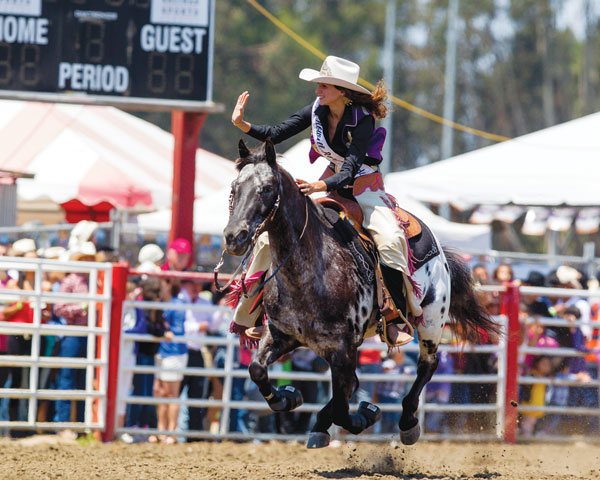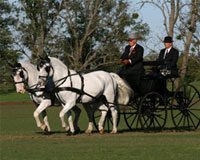
Spotted horse breeds are some of today’s most well-known breeds and it turns out they have a prehistoric past.
In 2011, however, researchers from Germany and England discovered the LP gene in DNA samples of prehistoric horses from Siberia and Eastern and Western Europe. The LP gene is the same dominant gene that appears in today’s most well-known spotted breeds: the Appaloosa, the Knabstrupper and the Pony of the Americas (POA). This is the gene responsible for those amazing spots.
Most Popular Spotted Horse Breed: The Appaloosa
Easily the most popular spotted horse breed in North America is the Appaloosa. Most historians believe the genes for the Appaloosa’s spotted coat first arrived by way of Spain with the Conquistadors, while a newer theory puts the Appaloosa’s ancestry in Asia. The theory suggests the horses came with Russian trappers who arrived in Alaska via the Bering Strait and made their way into Canada.

Wherever that amazing spot pattern came from, explorers Meriwether Lewis and William Clark first noticed it back in 1805 when they traveled into what would later be known as the Oregon Territory and spent time with the Nez Perce tribe. The Nez Perce were selectively breeding horses—something the European explorers had never seen among native tribes—and seemed to favor spots in their herds.
Close to the end of the 19th century, the spot-ted “Palouse” horses as they were later called, in honor of the Palouse Valley area of Washington State where they could be found in abundance, began to disappear. The Nez Perce had lost their freedom in the Nez Perce War of 1877, and their horses had started to vanish. While some ranchers in the West kept Appaloosas among their herds, the breed was in danger of dying out.
In 1937, a group of spotted horse breed lovers got together in an effort to save the breed. The Appaloosa Horse Club was founded, and by 1947, 200 horses were registered with the club. Today, 635,000 Appaloosa horses are registered.
Appaloosas are most well-known for their distinctive coat patterns, which include solid colors with a blanket (the blanket can be spotted or not); leopard patterns featuring dark spots on a white background; varnish roan colorations; and a variety of other patterns. White sclera around the eyes, striped hooves and mottled skin are other Appaloosa traits.
Appaloosas typically range from 14 to 16 hands in height. Their heads are straight and lean, and their ears are of medium size. They have a deep chest and well-muscled, sloping shoulders; their withers are prominent. The back is short and straight, and the hips are long, sloping and muscular.
These days, Appaloosas are prevalent in just about every equine sport. Along with racing, they are also seen in western working events, dressage, eventing, hunter/jumpers, gymkhanas and western pleasure events. Name a sport and the Appaloosa does it.
The Knabstrupper
Combine the beauty and athletic ability of a fine sport horse with an explosive pattern of spots, and you have the Knabstrupper, a spotted horse breed with an exotic European past.

Europeans domesticated horses some 6,000 years ago, and by 1400 B.C., spotted horses began appearing in the art of the ancient Egyptians. A Greek vase of that same period depicts a spotted horse, and an iron scabbard dated 800 B.C. bearing four spotted horses was found in Austria. It’s clear that the spot-ted horse had developed a presence throughout all of Europe.
In 1812, a Danish butcher named Flaeb bought a chestnut blanket mare from a Span-ish cavalry officer. The mare, named Flaebehoppen, was sold to Major Villars Lunn, who owned an estate called Knabstrupgaard. Lunn bred the mare to a Frederiksborg stallion, a member of Denmark’s oldest breed. The result was a wildly colored colt named Flaebehingsten. The colt and his dam were bred to a number of quality Danish horses and produced loudly colored horses of good type. Thus, the Knabstrupper breed was formed.

The fledgling breed hit hard times in the 1870s and was nearly lost. It wasn’t until 100 years later that a concerted effort was made to locate the horses that remained and revive the breed. Appaloosa stallions from the U.S. were used to infuse new blood, and the Knabstrupper found new life.
Three different types of Knabstruppers are currently recognized in Europe: sport horse, Baroque and pony. The sport horse type is known for its exceptional abilities in dressage, eventing and show jumping. The Baroque type is a shorter, broader horse reminiscent of a carriage or warhorse. The pony type is smaller and a favorite children’s mount.
Knabstruppers, who are prized for their kind temperaments, trainability and stamina, are somewhat rare in North America. As their spotted horse breed profile continues to grow as a colorful sport horse, we may begin to see more of them in the show ring.
The Pony of the Americas
In rural Iowa in the 1950s, an Appaloosa/Arabian-cross mare was accidentally bred to a Shetland Pony. Although skeptical of what the resulting foal would look like, a lawyer named Les Boomhower, who bred Shetland Ponies as a hobby, considered buying the mare. But first he wanted to see what the foal looked like.

When the small black-and-white spotted colt was born, Boomhower was sold on the pair. He named the foal Black Hand because of a marking on his coat that looked like a handprint, and he convinced other Shetland Pony breeders to consider making this colt the foundation of a new spotted pony breed. The group agreed, and the Pony of the Americas Club was born.
Early breeders of this new pony wanted a child-sized horse with color and versatility. Rules for Pony of the Americas (POA) characteristics were established, and equines that did not meet these requirements could not be registered. Ponies had to fall within the height limits of 44 and 52 inches. They had to have small heads with dished profiles, muscular bodies, and prominent Appaloosa coloring.
With its beautiful markings and petite size, the new spotted horse breed started to catch on. State clubs were formed and began holding local shows and sales. Eventually, a world championship show became an annual event, and shows are still held around the country each year.

Almost 70 years later, the POA has held true to its original purpose. The breed is still primarily meant for children and maintains its color and durability. Although the POA has grown somewhat in size (its height requirement changed to between 46 and 56 inches in 1986), it is essentially the same pony Boomhower conceived of shortly after the breed’s foundation sire was born.
These days, the Pony of Americas Club has more than 55,000 registered ponies in North America and Europe. POAs are ridden in almost every sport in the equine industry, from western pleasure and dressage to competitive trail riding. Some of the disciplines offered at POA-approved events include hunter, pleasure driving, trail and a newly added class called ranch riding, a pattern class with various maneuvers that showcase the vast versatility of the POA breed.
Resources for Spotted Horse Breeds ◆ International Colored Appaloosa Association ◆ Knabstrupper Network of North America ◆ Further Reading: Spot the Difference: The Appaloosa and Knabstrupper |
This article about spotted horse breeds appeared in the May 2020 issue of Horse Illustrated magazine. Click here to subscribe!





